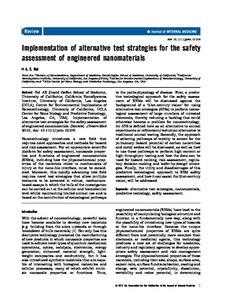Implementation of alternative test strategies for the safety assessment of engineered nanomaterials

2013
274
6
17 p.
evaluation of technique ; prediction ; risk assessment ; toxicity evaluation ; nanomaterials ; nanotechnology
Risk assessment and risk management
http://dx.doi.org/10.1111/joim.12109
English
Bibliogr.
"Nanotechnology introduces a new field that requires novel approaches and methods for hazard and risk assessment. For an appropriate scientific platform for safety assessment, nanoscale properties and functions of engineered nanomaterials (ENMs), including how the physicochemical properties of the materials relate to mechanisms of injury at the nano-bio interface, must be considered. Moreover, this rapidly advancing new field requires novel test strategies that allow multiple toxicants to be screened in robust, mechanism-based assays in which the bulk of the investigation can be carried out at the cellular and biomolecular level whilst maintaining limited animal use and is based on the contribution of toxicological pathways to the pathophysiology of disease. First, a predictive toxicological approach for the safety assessment of ENMs will be discussed against the background of a '21st-century vision' for using alternative test strategies (ATSs) to perform toxicological assessment of large numbers of untested chemicals, thereby reducing a backlog that could otherwise become a problem for nanotechnology. An ATS is defined here as an alternative to animal experiments or refinement/reduction alternative to traditional animal testing. Secondly, the approach of selecting pathways of toxicity to screen for the pulmonary hazard potential of carbon nanotubes and metal oxides will be discussed, as well as how to use these pathways to perform high-content or high-throughput testing and how the data can be used for hazard ranking, risk assessment, regulatory decision-making and 'safer-by-design' strategies. Finally, the utility and disadvantages of this predictive toxicological approach to ENM safety assessment, and how it can assist the 21st-century vision, will be addressed."
Digital
The ETUI is co-funded by the European Union. Views and opinions expressed are however those of the author(s) only and do not necessarily reflect those of the European Union or the ETUI.